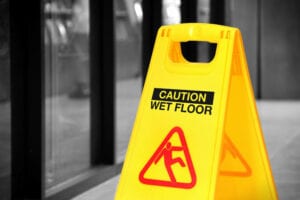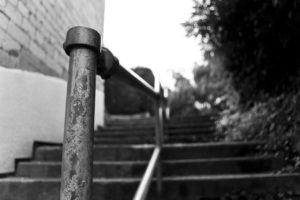Slip & Fall Attorneys in San Francisco

At Callaway & Wolf, our San Francisco slip and fall lawyers have handled cases including trips & slips on slippery or defective stairs, food, water, or other things left on floors, and sidewalk falls.
Other cases have involved places where the California building code requires a railing, such as stairs, or simply the failure to provide enough lighting, or to sweep regularly.
Slip and Fall Cases We’ve Recently Won
- $800,000 for a woman who tripped and fell, sustaining a badly broken ankle, while protecting her dog from an unleashed dog which attacked it as she walked in Oakland.
- $290,000 for a woman who had a badly broken ankle when she slipped on a Nob Hill sidewalk that was slippery on a rainy day due to a light coating of green slime which had accumulated.
- $175,000 for a woman who had a broken leg when she tripped on an uneven sidewalk in Sausalito.
- $163,000 for a woman who sustained a torn hamstring in a fall on a slippery sidewalk adjacent to Alta Plaza Park in San Francisco, where improper drainage caused the area to be constantly wet and slippery.
- $170,000 for a man who fell while trying to step over a large puddle of water which had accumulated at the bottom of the stairs at the Powell BART station, and had a knee injury.
- $100,000 for a man who fell in the lobby of his low-income apartment building in San Franciso’s Tenderloin neighborhood, breaking his leg. The client fell due to some water on the floor, which had been tracked in by other people. We were able to get a sworn statement from the building’s lobby attendant, and had an expert come in to do “coefficient of friction” testing on the lobby floor.
Slip and Fall Injuries Cause Serious Injuries and Fatalities
With 161,374 yearly slip and fall injuries and 34,573 related fatalities in the U.S., according to a recent Center for Disease Control (CDC) report, slip and fall injuries are common. Too often, many injuries are serious and life-altering, and some end in fatalities. Increased awareness about these injuries and understanding of how avoidable they are has resulted in lots of improvements we all can see, but there is still a long way to go.
These are what lawyers call premises liability claims. The negligence which forms the basis for the claim is a defect in premises, resulting in harm from a slip and fall accidents. California premises liability laws set the legal responsibility of owners and occupiers of property to keep areas safe from potential hazards. If you or a family member was seriously injured due to a slip & fall or other injury on another’s property, contact Callaway & Wolf to schedule a free consultation regarding potential compensation
The basic statute (law) setting forth the premises liability law is Civil Code Section 1714:
“Everyone is responsible, not only for the result of his or her willful acts, but also for an injury occasioned to another by his or her want of ordinary care or skill in the management of his or her property or person, except so far as the latter has, willfully or by want of ordinary care, brought the injury upon himself or herself.”

When you or a loved one were injured in a slip and fall accident, there are many other factors to consider, including but not limited to, previous complaints about an existing hazard, determining the negligence of a business or property owner and determining negligence, if applicable, of the injured individual. In virtually every case, there will be allegations of comparative fault or negligence.
Often the owner of the premises claims that the hazard was “open and obvious,” so that it could have been avoided if the claimant had been looking where they were going. In other cases they will allege that there was no notice, or that the defect in the premises was trivial, and thus not legally actionable.
There will also be questions asked about any other factors which could support a defense of comparative fault, such as
- What kind of shoes the injured person was wearing
- What the injured person was doing, where they were looking, etc.
- What the injured person was carrying at the time of the incident
Generally, common slip and falls occur because of:
- Loose and uneven floors and sidewalks
- Cluttered stores and homes
- Substances and liquids on floors
- Elevator and escalator accidents
- Inadequate lighting
- Unsteady staircases and loose handrails
Unsafe Stairs or Railings That do not Meet Building Code Specifications

If the property owner does not use common sense and should have known conditions were dangerous or hazardous and failed to either fix the hazard or give a clear warning, they are liable for injuries to persons legally on their property.
To build a slip and fall injury case, it’s necessary to compile evidence, including any photos of the dangerous scene, witness testimony if someone saw you fall, accident reports, medical records and any evidence you can acquire about what caused your fall. As the claimant, you have what’s called “the burden of proof.” Also, should the property owner or their insurance company question your culpability in your injuries, which they will likely do, if possible, you should collect and safeguard items that caused your slip or trip. Saving the shoes you wore, for example, is important to show that they were reasonable. High heels or very worn shoes with slick bottoms make a case more difficult.
Premises liability and slip, or trip and fall cases are very tough. We look at reported verdicts and case outcomes for California and see that a majority of these cases which go to trial lose completely. Defendants see the same reports of course, and as a result they often contest these cases strongly. They are much less likely to settle easily than many other types of injury cases. Often expensive experts are involved. The hard-fought nature of this practice area, with its greater burden of work and expense, raises the bar for the size of a feasible case. This is why people who have had relatively minor injuries in a fall often have a harder time getting a lawyer to help.
Contact a skilled San Francisco slip & fall lawyer at Callaway & Wolf who can help you gather the information needed to pursue your slip and fall injury claim, including the retrieval of your accident and medical records. It’s CRITICAL not to wait. The more time that passes after your injury, the more likely the accident scene will be cleaned or repaired, which will make winning a successful personal injury claim more challenging. However, if some time has passed and evidence is gone, medical records documenting your injuries and witnesses and medical experts can still prove valuable for successfully securing monetary compensation from the property owner.
When you’ve been injured because of a slip and fall on someone else’s property, to successfully pursue a premises liability monetary settlement will almost always require the assistance of an experienced slip and fall legal team.
Callaway & Wolf’s lawyers are highly experienced in premises liability law and slip and fall injuries. As your law firm, our knowledgeable, skilled legal team will determine liability exists in your particular case. If we determine it does, we will vigilantly negotiate and fight for your medical expenses, any lost wages, pain and suffering or a wrongful death when a loved one is injured due to a trip or slip and fall. Callaway & Wolf’s San Francisco slip & fall attorneys have the ability to uncover the truth and hold those who are responsible financially accountable.
As well known personal injury attorneys who are respected by peers and adversaries, founding partner Boone Callaway have successfully handled hundreds of personal injury cases in San Francisco and throughout the Bay Area. Backed by our well-honed negotiation strategies and litigation savvy, when we represent you, we’ll collect the facts of your case, review your medical records, and assess the property owner’s culpability in your injuries or a loved one’s death.
California Sidewalk Laws
Most sidewalk falls in San Francisco are caused by a raised slab, where two slabs come together, being pushed up by tree roots. In these cases, it’s all about how much height difference there is. If the difference is less than an inch, it can be tough for the case to survive California’s “trivial defect” rule. Many towns and cities have laws holding the adjacent landowner responsible for bad sidewalks that cause injuries. Some even set a standard for the amount of the defect. Sausalito, for example, has a half-inch rule in its sidewalk ordinance.
California’s Statute of Limitations on Slip and Fall Injuries
California has a two-year statute of limitations for slip and fall injuries. This is the time in which your case must be settled, or filed in court. This time limit shrinks to six months if the state or a city is responsible. If a governmental entity such as the State, or a city or county entity such as BART is involved, this time limit shrinks down to just six months for a claim filing deadline (see California Tort Claims Act). Even though you may have plenty of time before your time limit is up, our attorneys can help guide you through the process from day one, helping to insure that the proper groundwork is done for your slip and fall claim.
Contact an Experienced Slip & Fall Lawyer Serving the Bay Area
Our lawyers are experienced in handling sidewalk and slip and fall injury claims. If you or someone you know has been injured in a slip and fall accident in the San Francisco Bay Area, call 415-541-0300 to request a free consultation with an attorney. With over two decades experience handling personal injury cases, our law firm possesses the knowledge, financial capital, resources and support staff necessary to uncover the truth and hold the property owner who caused your injuries, or the death of a loved one, accountable for their dangerous property conditions. Callaway & Wolf’s extensive record of MULTI-MILLION-DOLLAR verdicts and settlements for our clients assures that we will aggressively battle on your behalf.
What’s more, though investigating, preparing, negotiating and filing civil lawsuits is highly costly, Callaway & Wolf will never charge you any money up-front. Because we work on a contingency basis, we’ll only get paid when we win and acquire your just monetary settlement.
Slip and Fall Case FAQs
Isn’t the property owner responsible if I fell or slipped on their property?
You have to be able to prove that the owner or one of their employees did something wrong to cause the problem, or at least knew about the problem and failed to fix it. If you can show that the problem was there for a significant amount of time, the owner is deemed on “constructive” notice of the danger, and can be held liable even without any evidence that he/she actually knew about it.
What will they do to try to avoid paying?
In most slip or trip and fall cases, the other party will claim that the victim was not looking where they were going, as whatever caused them to fall was “open and obvious.” They will also ask about what shoes you were wearing, what you were carrying, where you were going and why, and how familiar you were with the area–anything to try to shift blame for the fall. These cases are often fought – many of them cannot be settled without a lawsuit.
